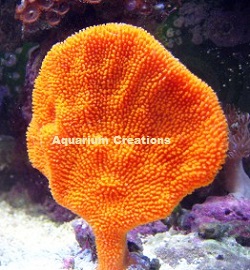Orange Fan Sponge

Description
A Fan sponge is naturally shaped like a Japanese hand held fan. They are natural suspension feeders,filtering food from the water. Phytoplankton foods bring outlot's of color. They are very helpful in filtering aquarium water.They can withstand a wide temperature variation and they last indefinitely in the marine aquarium.
Like other Sponges, the Orange Fan Sponge filter feeds plankton food from the ocean's water. Sponges can usually tolerate changesin water temperature with no ill effect. The Orange Fan Sponge requires moderate light and moderate water movement to survive. Many beginning hobbyists loose sponges because they do not provide enough light or food. The Orange Fan sponge's shape can vary quite a lot, but all pieces look unique and beautiful.
The most critical concern when receiving your sponge and placing it in your aquarium is that it can never be exposed to air. The air becomes trapped in the sponges channels that line the inside of the sponges body. With trapped air blocking the channels, the food has no pathway for the sponge to eat, which starves the sponge, ultimately killing the sponge.
Food & Supplements:
To keep your sponge healthy it will require supplemental feedings from any of the available liquid Plankton Foods and other foods made up of dissolved organics.
Level of Care:
Moderate
Approximate Purchase Size:
Small 1-1/2" to 3"; Medium 3" to 4"; Large 5" to 7"
|
Small$39.99
Medium $59.99
Large$99.99
|
|

